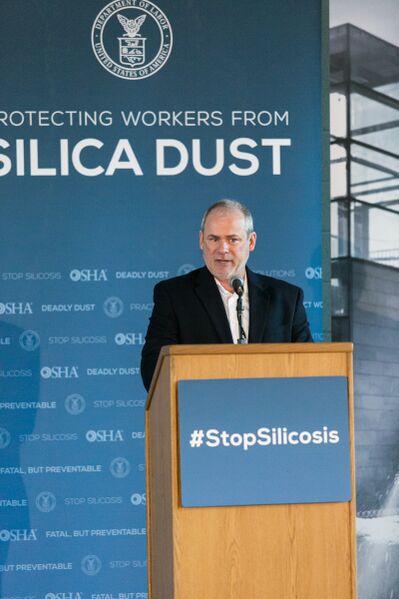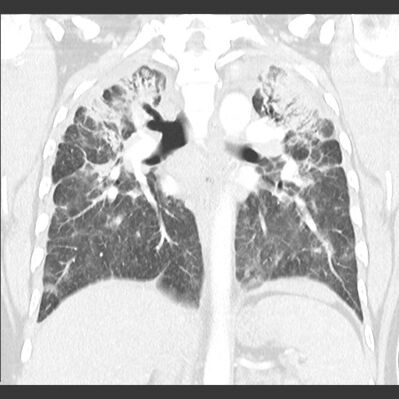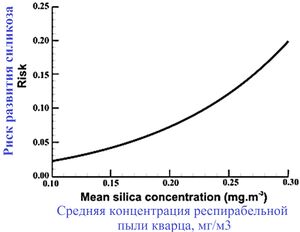Silicosis: Difference between revisions
No edit summary |
m (Vidya Acharya moved page Role of Pulmonary Rehabilitation in Silicosis to Silicosis: More appropriate ) |
||
| (8 intermediate revisions by one other user not shown) | |||
| Line 1: | Line 1: | ||
<div class="editorbox"> | <div class="editorbox"> | ||
'''Original Editor '''- [[User: | '''Original Editor '''- [[User:Lucinda hampton|Lucinda hampton]] | ||
'''Top Contributors''' - {{Special:Contributors/{{FULLPAGENAME}}}} | '''Top Contributors''' - {{Special:Contributors/{{FULLPAGENAME}}}} | ||
</div> | </div> | ||
== Introduction == | == Introduction == | ||
[[File:Silicosis OH.jpeg|right|frameless|599x599px]] | |||
Silicosis is occupational pneumoconiosis (the general term for a class of interstitial lung diseases where inhalation of dust has caused interstitial fibrosis) caused by inhalation of crystalline silicon dioxide. Silica is in quartz, sand, stone, soil, granite, brick, cement, grout, mortar, bitumen and engineered stone products. | |||
= | This disease is one of several well-described pulmonary complications associated with toxic exposures in the workplace.<ref name=":3">Mlika M, Adigun R, Bhutta BS. [https://www.ncbi.nlm.nih.gov/books/NBK537341/ Silicosis]. StatPearls [Internet]. 2021 Feb 7.Available from: https://www.ncbi.nlm.nih.gov/books/NBK537341/ (accessed 11.5.2021)</ref> | ||
= | * Any occupation disturbing the earth’s crust increases the risk of silicosis. eg sand blasting, cutting, excavating, building on sandstone, demolition work, tunnelling, quarry work and mining. Air-polishing concrete, foundry work, bricklaying, stone masonry, and making glass and ceramics also increase the risk<ref name=":2">The Conversation [https://theconversation.com/explainer-what-is-silicosis-and-why-is-this-old-lung-disease-making-a-comeback-80465 Explainer: what is silicosis and why is this old lung disease making a comeback?]Available from: https://theconversation.com/explainer-what-is-silicosis-and-why-is-this-old-lung-disease-making-a-comeback-80465<nowiki/>(accessed 11.5.2021)</ref>. | ||
* One of the fastest growing occupational groups we’re seeing with silicosis are people who make and install engineered stone products, the type of benchtops and tiles you might find in your kitchen or bathroom. | |||
== | == Etiology == | ||
* | Inhalation of the crystalline compound form of Silica can lead to [[Respiratory Disorders|pulmonary disease.]] As silica deposits in the airways, contact with the [[Alveoli|alveolar]] and endobronchial surfaces generates [[Free Radicals|reactive oxygen species]]. Smaller particles are taken up through phagocytosis into macrophages, which generate additional free radicals. Oxidative damage by activated macrophages and silica particles result in the release of inflammatory [[cytokines]], increase in cell signaling, and [[apoptosis]] of parenchymal cells and macrophages. Fibroblast infiltration occurs in a nodular pattern as the disease progresses.<ref name=":3" /> | ||
* | |||
== History and Physical == | |||
[[File:Silicosis.jpeg|right|frameless|399x399px]] | |||
Image: Frontal Xray - Both lungs show reticulonodular confluent opacities within the mid and upper zones and some degree of volume loss. Obliteration of the paratracheal stripes inferring mediastinal lymphadenopathy.The disease occurs in two clinical forms that are subdivided by their temporal relationship to the exposure to silica: | |||
# acute silicosis: manifests as alveolar silicoproteinosis | |||
# classic silicosis: manifests as a chronic interstitial reticulonodular disease | |||
The classic form is much more common than the acute form and can be classified as simple or complicated, according to the radiographic findings: | |||
* simple silicosis: pattern of small and round or irregular opacities that you can see on a chest [[X-Rays|x-ray]] or [[CT Scans|CT scan]]. | |||
* complicated silicosis: large conglomerate opacities and large areas of scarring, called progressive massive fibrosis<ref name=":4">Radiopedia Silicosis Available from:https://radiopaedia.org/articles/silicosis (accessed 12.5.2021)</ref>. | |||
In general, the more scarring and the more widespread it is, the more trouble people have breathing as their [[Lung Anatomy|lung]]<nowiki/>s lose their capacity to expand and contract with each breath. Silicosis also increases people’s susceptibility to [[Tuberculosis|tuberculosis.]]<ref name=":2" /> | |||
== Diagnosis == | |||
Diagnosis of silicosis can be made by History of patient which may include duration of exposure, type of mining/grinding work, various other Laboratory and Radiological Investigation. [[Pulmonary Function Test|Pulmonary function testing]], [[Cardiopulmonary Exercise Testing (CPET) In Adults|exercises tolerance testing]] and [[Respiratory Assessment|chest examination]] are some of tool which can proved a physical therapist idea about lung health, [[Lung Volumes|lung capacity]] and [[Lung Compliance|compliance]].<ref name=":1">Trivedi S,Effect of Pulmonary Rehabilitation on Functional Capacity of Lungs and Dyspnea in Patient with Silicosis in Anand District of Gujarat,Indian Journal of Physiotherapy and Occupational Therapy. July-September 2017, Vol. 11, No. 3,DOI Number: 10.5958/0973-5674.2017.00105.8</ref> | |||
== Treatment and Prognosis == | |||
Treatment is to remove the exposure, although silicosis may progress despite removal from the dust environment. | |||
* In acute silicosis particularly, the clinical course is usually progressive and ends in death due to [[Heart Failure|cor pulmonale]] and [[Respiratory Failure|respiratory failure]] | |||
* Carcinoma and tuberculosis are potentially serious complications of silicosis.<ref name=":4" /> | |||
== | == Physiotherapy == | ||
[[File:Exercise Bike.gif|right|frameless]] | |||
The role of Physiotherapy is well established in [[Introduction to Occupational Health|occupational]] lung disease. Silicosis is an ancient occupational lung disease with high incidence and prevalence, however the role of pulmonary physiotherapy is yet not established.<ref name=":0">https://www.cdc.gov/niosh/learning/b-reader/pathology/silicosis/1.html</ref> | |||
* Preventive measure or providing a risk free work environment is consider as an important aspect in prevention/management. | |||
* In patients who have already developed silicosis it can be treated with respiratory Physiotherapy <ref name=":0" />. Role of Physiotherapy in various occupation lung diseases is available in various research.<ref name=":1" /> | |||
The following are some of the problems faced by patients which physiotherapists can address | |||
* Dyspnea | |||
* Altered lung function | |||
* Dyspnea | * Increased work of breathing and respiratory rate | ||
* Altered lung function | * Chest pain & tightness | ||
* Increased work of breathing and respiratory rate | * Mucus accumulation | ||
* Chest pain & tightness | * Altered breathing mechanics | ||
* Mucus accumulation | * Altered quality of life | ||
* Altered breathing mechanics | * Fatigue | ||
* Altered quality of life | |||
* Fatigue | |||
[[Pulmonary Rehabilitation|Pulmonary rehabilitation]] is a comprehensive intervention based on a thorough patient assessment followed by patient-tailored therapies, which include, but are not limited to, exercise training, education, and behavior change, designed to improve the physical and psychological condition of people with chronic respiratory disease and to promote the long-term adherence of health-enhancing behaviors. It is believed that tailor made pulmonary rehabilitation has significant impact on above mentioned problems in not only COPD but also in occupational lung disease such as silicosis. | |||
Pulmonary rehabilitation mainly includes: | |||
* Patient Education & Behavioral management | |||
* Exercises Training | |||
- It further can cover various aspects of management such as | - It further can cover various aspects of management such as | ||
* Nutritional counseling | |||
* Education about your disease and how to manage it | |||
* Breathing strategies | |||
* Psychological counseling and/or group support. | |||
Be sure to check out the link above for specifics | |||
== How can we prevent Silicosis? == | |||
[[File:Silicosis risk.jpeg|right|frameless]] | |||
Diseases due to silica exposure (eg silicosis, lung cancer, connective tissue disorders, kidney disease and chronic obstructive lung disease) are entirely preventable. | |||
Image: Risks for chronic silicosis in relation to respirable silica concentration (<2 mg/m3) averaged over 15 years. | |||
* Wetting of silica dust, using appropriate exhaust ventilation and extraction hoods, and wearing the right dust masks and air filters all reduce the chances of someone breathing in silica dust at work. | |||
* There are also workplace standards on exposure to silica dust. And workplace screening for lung disease is mandatory for those at significant risk, which can include a physical examination as well as x-rays and lung function tests.<ref name=":2" /> | |||
== Resources == | |||
For understanding Pathology, Signs and Symptoms have a look at below videos of <u>American Lung Association</u> https://www.youtube.com/watch?v=1FZS8s3KdTA&feature=youtu.be and <u>Dr.G Bhanu Prakash Animated Medical Videos</u> https://www.youtube.com/watch?v=6yEtisMfyMY Also check what Occupational Safety and Health Administration states abut silicosis at https://www.osha.gov/Publications/silicosis.html | |||
=== | == References == | ||
<references /> | <references /> | ||
[[Category:Respiratory Disease - Conditions]] | |||
[[Category:Respiratory]] | |||
[[Category:Respiratory Disease - Interventions]] | |||
[[Category:Global Health]] | |||
Latest revision as of 14:27, 27 October 2022
Original Editor - Lucinda hampton
Top Contributors - Lucinda hampton, Shreya Trivedi and Vidya Acharya
Introduction[edit | edit source]
Silicosis is occupational pneumoconiosis (the general term for a class of interstitial lung diseases where inhalation of dust has caused interstitial fibrosis) caused by inhalation of crystalline silicon dioxide. Silica is in quartz, sand, stone, soil, granite, brick, cement, grout, mortar, bitumen and engineered stone products.
This disease is one of several well-described pulmonary complications associated with toxic exposures in the workplace.[1]
- Any occupation disturbing the earth’s crust increases the risk of silicosis. eg sand blasting, cutting, excavating, building on sandstone, demolition work, tunnelling, quarry work and mining. Air-polishing concrete, foundry work, bricklaying, stone masonry, and making glass and ceramics also increase the risk[2].
- One of the fastest growing occupational groups we’re seeing with silicosis are people who make and install engineered stone products, the type of benchtops and tiles you might find in your kitchen or bathroom.
Etiology[edit | edit source]
Inhalation of the crystalline compound form of Silica can lead to pulmonary disease. As silica deposits in the airways, contact with the alveolar and endobronchial surfaces generates reactive oxygen species. Smaller particles are taken up through phagocytosis into macrophages, which generate additional free radicals. Oxidative damage by activated macrophages and silica particles result in the release of inflammatory cytokines, increase in cell signaling, and apoptosis of parenchymal cells and macrophages. Fibroblast infiltration occurs in a nodular pattern as the disease progresses.[1]
History and Physical[edit | edit source]
Image: Frontal Xray - Both lungs show reticulonodular confluent opacities within the mid and upper zones and some degree of volume loss. Obliteration of the paratracheal stripes inferring mediastinal lymphadenopathy.The disease occurs in two clinical forms that are subdivided by their temporal relationship to the exposure to silica:
- acute silicosis: manifests as alveolar silicoproteinosis
- classic silicosis: manifests as a chronic interstitial reticulonodular disease
The classic form is much more common than the acute form and can be classified as simple or complicated, according to the radiographic findings:
- simple silicosis: pattern of small and round or irregular opacities that you can see on a chest x-ray or CT scan.
- complicated silicosis: large conglomerate opacities and large areas of scarring, called progressive massive fibrosis[3].
In general, the more scarring and the more widespread it is, the more trouble people have breathing as their lungs lose their capacity to expand and contract with each breath. Silicosis also increases people’s susceptibility to tuberculosis.[2]
Diagnosis[edit | edit source]
Diagnosis of silicosis can be made by History of patient which may include duration of exposure, type of mining/grinding work, various other Laboratory and Radiological Investigation. Pulmonary function testing, exercises tolerance testing and chest examination are some of tool which can proved a physical therapist idea about lung health, lung capacity and compliance.[4]
Treatment and Prognosis[edit | edit source]
Treatment is to remove the exposure, although silicosis may progress despite removal from the dust environment.
- In acute silicosis particularly, the clinical course is usually progressive and ends in death due to cor pulmonale and respiratory failure
- Carcinoma and tuberculosis are potentially serious complications of silicosis.[3]
Physiotherapy[edit | edit source]
The role of Physiotherapy is well established in occupational lung disease. Silicosis is an ancient occupational lung disease with high incidence and prevalence, however the role of pulmonary physiotherapy is yet not established.[5]
- Preventive measure or providing a risk free work environment is consider as an important aspect in prevention/management.
- In patients who have already developed silicosis it can be treated with respiratory Physiotherapy [5]. Role of Physiotherapy in various occupation lung diseases is available in various research.[4]
The following are some of the problems faced by patients which physiotherapists can address
- Dyspnea
- Altered lung function
- Increased work of breathing and respiratory rate
- Chest pain & tightness
- Mucus accumulation
- Altered breathing mechanics
- Altered quality of life
- Fatigue
Pulmonary rehabilitation is a comprehensive intervention based on a thorough patient assessment followed by patient-tailored therapies, which include, but are not limited to, exercise training, education, and behavior change, designed to improve the physical and psychological condition of people with chronic respiratory disease and to promote the long-term adherence of health-enhancing behaviors. It is believed that tailor made pulmonary rehabilitation has significant impact on above mentioned problems in not only COPD but also in occupational lung disease such as silicosis.
Pulmonary rehabilitation mainly includes:
- Patient Education & Behavioral management
- Exercises Training
- It further can cover various aspects of management such as
- Nutritional counseling
- Education about your disease and how to manage it
- Breathing strategies
- Psychological counseling and/or group support.
Be sure to check out the link above for specifics
How can we prevent Silicosis?[edit | edit source]
Diseases due to silica exposure (eg silicosis, lung cancer, connective tissue disorders, kidney disease and chronic obstructive lung disease) are entirely preventable.
Image: Risks for chronic silicosis in relation to respirable silica concentration (<2 mg/m3) averaged over 15 years.
- Wetting of silica dust, using appropriate exhaust ventilation and extraction hoods, and wearing the right dust masks and air filters all reduce the chances of someone breathing in silica dust at work.
- There are also workplace standards on exposure to silica dust. And workplace screening for lung disease is mandatory for those at significant risk, which can include a physical examination as well as x-rays and lung function tests.[2]
Resources[edit | edit source]
For understanding Pathology, Signs and Symptoms have a look at below videos of American Lung Association https://www.youtube.com/watch?v=1FZS8s3KdTA&feature=youtu.be and Dr.G Bhanu Prakash Animated Medical Videos https://www.youtube.com/watch?v=6yEtisMfyMY Also check what Occupational Safety and Health Administration states abut silicosis at https://www.osha.gov/Publications/silicosis.html
References[edit | edit source]
- ↑ 1.0 1.1 Mlika M, Adigun R, Bhutta BS. Silicosis. StatPearls [Internet]. 2021 Feb 7.Available from: https://www.ncbi.nlm.nih.gov/books/NBK537341/ (accessed 11.5.2021)
- ↑ 2.0 2.1 2.2 The Conversation Explainer: what is silicosis and why is this old lung disease making a comeback?Available from: https://theconversation.com/explainer-what-is-silicosis-and-why-is-this-old-lung-disease-making-a-comeback-80465(accessed 11.5.2021)
- ↑ 3.0 3.1 Radiopedia Silicosis Available from:https://radiopaedia.org/articles/silicosis (accessed 12.5.2021)
- ↑ 4.0 4.1 Trivedi S,Effect of Pulmonary Rehabilitation on Functional Capacity of Lungs and Dyspnea in Patient with Silicosis in Anand District of Gujarat,Indian Journal of Physiotherapy and Occupational Therapy. July-September 2017, Vol. 11, No. 3,DOI Number: 10.5958/0973-5674.2017.00105.8
- ↑ 5.0 5.1 https://www.cdc.gov/niosh/learning/b-reader/pathology/silicosis/1.html










